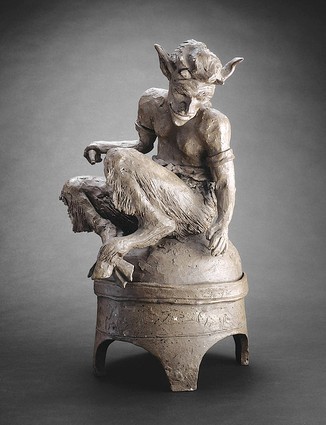Though not a story about an original prop from film or television, recent reporting about a sculpture identified as fraud by the Art Institute of Chicago is most definitely a story of interest for fellow hobbyists.
As reported by the Chicago Tribune (below), “The Faun” ceramic sculpture has been on display at the Art Institute of Chicago for the last ten years, believed to be an original 19th Century work of Paul Gauguin. This past week, the museum announced the work is a forgery. The museum bought the piece in 1997 from a dealer in London, who, in turn, purchased the piece from Sotheby’s in 1994.
A family (father, mother, son) named Greenhalgh are believed to have run a very advanced forgery operation for the last 17 years, and were the consignors to Sotheby’s. The son, Shaun, has already been sentenced to over four years in prison following his confession.
I believe stories such as this (as well as the recent “Fraud Trial Features Famous Firearms“) have direct correlations with our own hobby, in which fraud (not to mention theft) is prevalent with much less oversight. Also of interest, in this article, is the reference to Sotheby’s indemnification clause:
Buyers at major auctions generally are protected by an indemnification clause that allows the sale to be rescinded if the works turn out to be inauthentic. Sotheby’s might go back to the Greenhalgh family to refund the purchase price.
Generally speaking, at the major auction houses for original prop collectors (including Sotheby’s), no such clause applies for props and wardrobe from film and television. So, an equivalent finding of fraud in the original prop hobby would likely have no such recourse for the owner of the piece.
Here is the full story from the Chicago Tribune: below. There is also an interesting related story at the Chicago Tribune website: Why a fake Gauguin found its way to the Art Institute
Art Institute of Chicago discloses Gauguin sculpture in fact a forgery
Sculpture sold as a Gauguin is fake
The Art Institute of Chicago has discovered that a sculpture alleged to be a 19th Century work by Paul Gauguin is a forgery. (Photo courtesy The Art Institute of Chicago / December 11, 2007)By Alan G. Artner | Tribune art critic
December 12, 2007For about a decade, “The Faun,” a ceramic sculpture, has been at the Art Institute of Chicago, presented as a work of the 19th Century French master Paul Gauguin.
On Tuesday, the museum announced that the work, which it bought in 1997, is a forgery. “The Faun” has been confirmed to be one of a long string of contemporary forgeries by the Greenhalgh family, which Scotland Yard had been investigating for 20 months.
The museum purchased the sculpture from a private dealer in London, who had bought it at a Sotheby’s auction in 1994.
“Everyone who bought and sold [the work] did so in good faith,” said Erin Hogan, director of public affairs at the institute.
“No one could think of any other instance in which anything like this happened here,” Hogan said. “So we don’t have experience in this area. We’re talking to both Sotheby’s and the private dealer about how to proceed” to get compensated for the money it spent to buy the work. As is customary, the institute did not reveal the purchase price.
The piece was the object of art historical research upon acquisition, but there was no reason to believe it was anything other than represented, Hogan said.
The sculpture was on display at the museum until October. Shaun Greenhalgh, who made all the objects forged by the family, confessed to authorities that “The Faun” was his handiwork. The family had consigned it to Sotheby’s.
Buyers at major auctions generally are protected by an indemnification clause that allows the sale to be rescinded if the works turn out to be inauthentic. Sotheby’s might go back to the Greenhalgh family to refund the purchase price.
Shaun Greenhalgh received a prison sentence of 4 years and 8 months last month. His mother, Olive, 83, was given a 12-month suspended sentence. The father, George, 84, salesman of all the forged objects, had a deferred sentence pending medical reports.
For 17 years, the family carried on one of the most sophisticated forgery operations in modern history, faking scores of objects including antiquities, watercolors, paintings and modern sculpture, authorities said. Many of the pieces were copies of ancient objects or artworks thought to be lost.
Their “reappearance” caused great excitement. Family members brought several pieces to experts and museums with elaborate stories of inheritance. Detailed accounts of previous owners also were supplied — and also were invented.
According to the Daily Mail in London, “the conspiracy secured them around 1.2 million [euros],” or about $1.77 million. “Had all the items forged been sold, experts estimated the family could have earned as much as 14 million [euros],” or about $20.6 million.
———–

